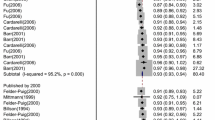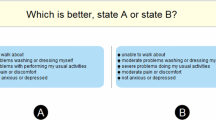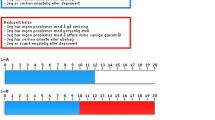Abstract
A variety of methods are available to measure preferences for temporary health states for cost-utility analyses. The objectives of this review were to summarize the available temporary health-state valuation methods, identify advantages and disadvantages of each, and identify areas for future research.
We describe the key aspects of each method and summarize advantages and disadvantages of each method in terms of consistency with QALY theory, relevance to temporary health-state-specific domains, ease of use, time preference, and performance in validation studies. Two broad categories of methods were identified: traditional and adapted.
Traditional methods were health status instruments, time trade-off (TTO), and the standard gamble (SG). Methods adapted specifically for temporary health-state valuation were TTO with specified duration of the health state, TTO with a lifespan modification, waiting trade-off, chained approaches for TTO and SG, and sleep trade-off.
Advantages and disadvantages vary by method and no ‘gold standard’ method emerged. Selection of a method to value temporary health states will depend on the relative importance of the following considerations: ability to accurately capture the unique characteristics of the temporary health state, level of respondent burden and cognition, theoretical consistency of elicited preference values with the overall purpose of the study, and resources available for study development and data collection. Further research should focus on evaluating validity, reliability and feasibility of temporary health-state valuation methods.
Similar content being viewed by others
References
Prosser LA, Lieu TA. Comments on the Prosser et al. approach to value disease reduction in children. Pediatrics 2004 Nov; 114(5): 1375–6
Dolan P, Stalmeier P. The validity of time trade-off values in calculating QALYs: constant proportional time trade-off versus the proportional heuristic. J Health Econ 2003 May; 22 (3): 445–58
Bala M, Wood L, Zarkin G, et al. Are health states ‘timeless’? The case of the standard gamble method. J Clin Epidemiol 1999; 52(11): 1047–53
The cost-effectiveness analysis registry 2005 [online]. Available from URL: http://research.tufts-nemc.org/cear/default.aspx [Accessed 2008 Mar 1]
Drummond MF, Sculpher MJ, Torrance GW, et al. Methods for the economic evaluation of health care programmes. 3rd ed. New York: Oxford University Press, 2005
Pliskin JS, Shepard DS, Weinstein MC. Utility functions for life years and health status. Operations Res 1980 01; 28 (1): 206–24
Dolan P. Output measures and valuation in health. In: Drummond MF, McGuire A, editors. Economic evaluation in health care. New York: Oxford University Press, 2001: 46–67
Bleichrodt H, Johannesson M. The validity of QALYs: an experimental test of constant proportional tradeoff and utility independence. Med Decis Making 1997 Jan–Mar; 17 (1): 21–32
Bleichrodt H, Wakker PP, Johannesson M. Characterizing QALYs by risk neutrality. J Risk Uncertain 1997; 15 (2): 107–14
Wakker P, Stiggelbout A. Explaining distortions in utility elicitation through the rank-dependent model for risky choices. Med Decis Making 1995 Apr–Jun; 15 (2): 180–6
Bleichrodt H, Diecidue E, Quiggin J. Equity weights in the allocation of health care: the rank-dependent QALY model. J Health Econ 2004 Jan; 23 (1): 157–71
Lazaro A, Barberan R, Rubio E. Private and social time preferences for health and money: an empirical estimation. Health Econ 2001 Jun; 10 (4): 351–6
Johannesson M, Pliskin JS, Weinstein MC. A note on QALYs, time tradeoff, and discounting. Med Decis Making 1994 Apr–Jun; 14 (2): 188–93
Turner D, Wailoo A, Nicholson K, et al. Systematic review and economic decision modelling for the prevention and treatment of influenza A and B. Leicester: University of Leicester and University of Sheffield, 2002 Apr 29
Swan JS, Fryback DG, Lawrence WF, et al. A time-tradeoff method for cost-effectiveness models applied to radiology. Med Decis Making 2000 Jan–Mar; 20 (1): 79–88
Yin D, Baum RA, Carpenter JP, et al. Cost-effectiveness of MR angiography in cases of limb-threatening peripheral vascular disease. Radiology 1995 Mar; 194 (3): 757–64
Griffiths TL, Phillips CJ, Davies S, et al. Cost effectiveness of an outpatient multidisciplinary pulmonary rehabilitation programme. Thorax 2001 Oct; 56 (10): 779–84
Lavernia CJ, Guzman JF, Gachupin-Garcia A. Cost effectiveness and quality of life in knee arthroplasty. Clin Orthop Relat Res 1997 Dec; 345: 134–9
Lieu TA, Ortega-Sanchez I, Ray GT, et al. Community and patient values for preventing Herpes zoster. Pharmacoeconomics 2008; 26 (3): 235–49
Swan JS, Lawrence WF, Roy J. Process utility in breast biopsy. Med Decis Making 2006 Jul–Aug; 26 (4): 347–59
Dominitz JA, Provenzale D. Patient preferences and quality of life associated with colorectal cancer screening. Am J Gastroenterol 1997 Dec; 92 (12): 2171–8
Badia X, Monserrat S, Roset M, et al. Feasibility, validity and test-retest reliability of scaling methods for health states: the visual analogue scale and the time trade-off. Qual Life Res 1999 Jun; 8 (4): 303–10
Jansen SJ, Stiggelbout AM, Wakker PP, et al. Patients’ utilities for cancer treatments: a study of the chained procedure for the standard gamble and time tradeoff. Med Decis Making 1998 Oct–Dec; 18 (4): 391–9
Oldridge N, Furlong W, Feeny D, et al. Economic evaluation of cardiac rehabilitation soon after acute myocardial infarction. Am J Cardiol 1993 Jul 15; 72 (2): 154–61
Pace KT, Dyer SJ, Phan V, et al. Laparoscopic v open donor nephrectomy: a cost-utility analysis of the initial experience at a tertiary-care center. J Endourol 2002 Sep; 16 (7): 495–508
Lee GM, Salomon JA, LeBaron CW, et al. Health-state valuations for pertussis: methods for valuing short-term health states. Health Qual Life Outcomes 2005; 3: 17
Prosser LA, Ray GT, O’Brien M, et al. Preferences and willingness to pay for health states prevented by pneumococcal conjugate vaccine. Pediatrics 2004 Feb; 113 (2): 283–90
Beutels P, Viney RC. Comments on the Prosser et al. approach to value disease reduction in children [author reply]. Pediatrics 2004 Nov; 114 (5): 1375–6
Prosser LA, Ladapo JA, Rusinak D, et al. Parental tolerance for false-positive newborn screening results. Arch Pediatr Adolesc Med 2008 Sep; 162 (9): 870–6
Swan JS, Sainfort F, Lawrence WF, et al. Process utility for imaging in cerebrovascular disease. Acad Radiol 2003 Mar; 10 (3): 266–74
Cook J, Richardson J, Street A. A cost utility analysis of treatment options for gallstone disease: methodological issues and results. Health Econ 1994 May–Jun; 3 (3): 157–68
Jansen SJ, Stiggelbout AM, Wakker PP, et al. Unstable preferences: a shift in valuation or an effect of the elicitation procedure? Med Decis Making 2000 Jan-Mar; 20 (1): 62–71
Locadia M, Stalmeier PF, Oort FJ, et al. A comparison of 3 valuation methods for temporary health states in patients treated with oral anticoagulants. Med Decis Making 2004 Nov-Dec; 24 (6): 625–33
McNamee P, Glendinning S, Shenfine J, et al. Chained time trade-off and standard gamble methods: applications in oesophageal cancer. Eur J Health Econ 2004 Feb; 5 (1): 81–6
Gage BF, Cardinalli AB, Owens DK. The effect of stroke and stroke prophylaxis with aspirin or warfarin on quality of life. Arch Intern Med 1996 Sep 9; 156 (16): 1829–36
Merlino LA, Bagchi I, Taylor TN, et al. Preference for fractures and other glucocorticoid-associated adverse effects among rheumatoid arthritis patients. Med Decis Making 2001 Mar–Apr; 21 (2): 122–32
Tosteson AN, Kneeland TS, Nease RF, et al. Automated current health time-trade-off assessments in women’s health. Value Health 2002 Mar–Apr; 5 (2): 98–105
Tosteson AN, Kneeland TS, Nease R. Feasibility of automated utility assessment in a phase III clinical trails: U-Titer and a raloxifene osteoporosis prevention trial. Med Decis Making 1995; 15: 412–36
Keeney R, Raiffa H. Decisions with multiple objectives: preferences and value tradeoffs. New York: Cambridge University Press, 1993
Torrance GW. Measurement of health state utilities for economic appraisal. J Health Econ 1986; 5: 1–30
Kaplan RM, Bush JW, Berry CC. Health status: types of validity and the index of well-being. Health Serv Res 1976 Winter; 11 (4): 478–507
Kaplan RM, Anderson JP, Wu AW, et al. The Quality of Well-Being scale: applications in AIDS, cystic fibrosis, and arthritis. Med Care 1989 Mar; 27 (3 Suppl.): S27–43
Anderson JP, Kaplan RM, Berry CC, et al. Interday reliability of function assessment for a health status measure: the Quality of Well-Being scale. Med Care 1989 Nov; 27(11): 1076–83
Kaplan RM, Anderson JP. An integrated approach to quality of life assessment: the general health policy model. In: Spilker B, editor. Quality of life in clinical studies. New York: Raven Press, 1990: 131–49
Torrance GW, Feeny DH, Furlong WJ, et al. Multiattribute utility function for a comprehensive health status classification system: Health Utilities Index Mark 2. Med Care 1996 Jul; 34 (7): 702–22
Shaw JW, Johnson JA, Coons SJ. US valuation of the EQ-5D health states: development and testing of the D1 valuation model. Med Care 2005 Mar; 43 (3): 203–20
Kaplan RM, Anderson JP, Ganiants TG. The Quality of Well-Being scale: rationale for a single quality of life index. In: Walker SR, Rosser RM, editors. Quality of life assessment: key issues in the 1990s. 2nd ed. New York: Springer-Verlag, 1999
Torrance GW, Thomas WH, Sackett DL. A utility maximization model for evaluation of health care programs. Health Serv Res 1972 Summer; 7 (2): 118–33
van Nooten F, Brouwer W. The influence of subjective expectations about length and quality of life on time trade-off answers. Health Econ 2004 Aug; 13 (8): 819–23
Cullen J, Schwartz MD, Lawrence WF, et al. Short-term impact of cancer prevention and screening activities on quality of life. J Clin Oncol 2004 Mar 1; 22 (5): 943–52
Rutten-van Molken MP. Methodological issues of patient utility measurement: experience from two clinical trials. Med Care 1995; 33 (9): 922–37
O’Connor AM. Effects of framing and level of probability on patients’ preferences for cancer chemotherapy. J Clin Epidemiol 1989; 42 (2): 119–26
Bennett KJ, Torrance GW. Measuring health state preferences and utilities: rating scale, time trade-off, and standard gamble techniques. In: Spilker B, editor. Quality of life and pharmacoeconomics in clinical trials. Philadelphia (PA): Lippincott-Raven, 1996: 253–65
Author information
Authors and Affiliations
Corresponding author
Rights and permissions
About this article
Cite this article
Wright, D.R., Wittenberg, E., Swan, J.S. et al. Methods for Measuring Temporary Health States for Cost-Utility Analyses. Pharmacoeconomics 27, 713–723 (2009). https://doi.org/10.2165/11317060-000000000-00000
Published:
Issue Date:
DOI: https://doi.org/10.2165/11317060-000000000-00000




